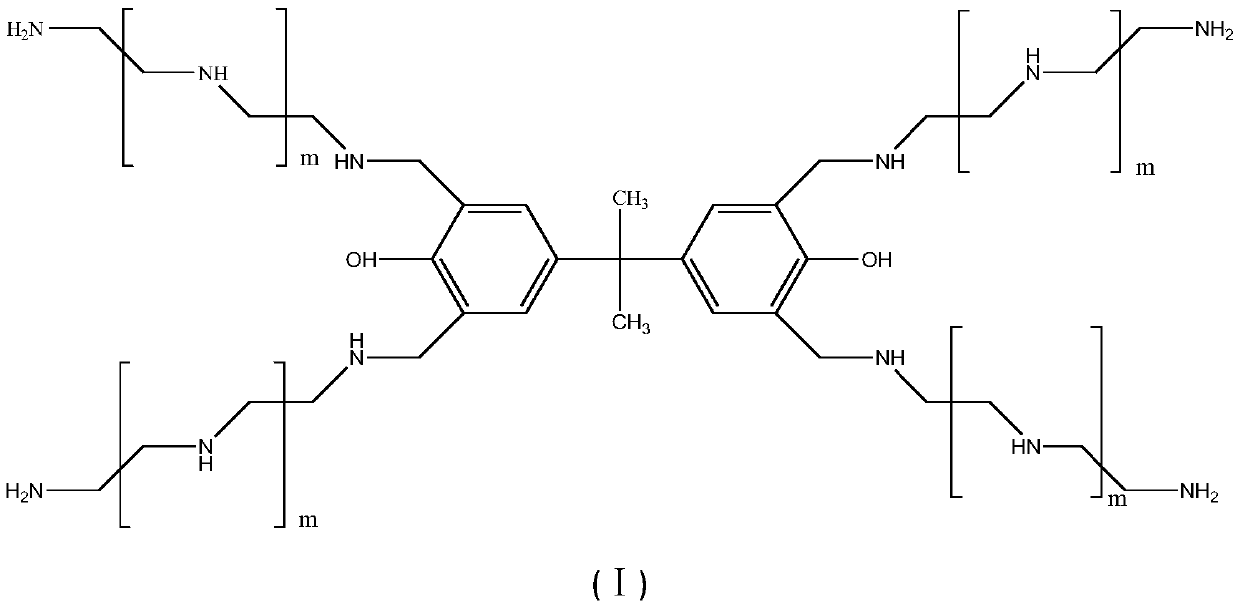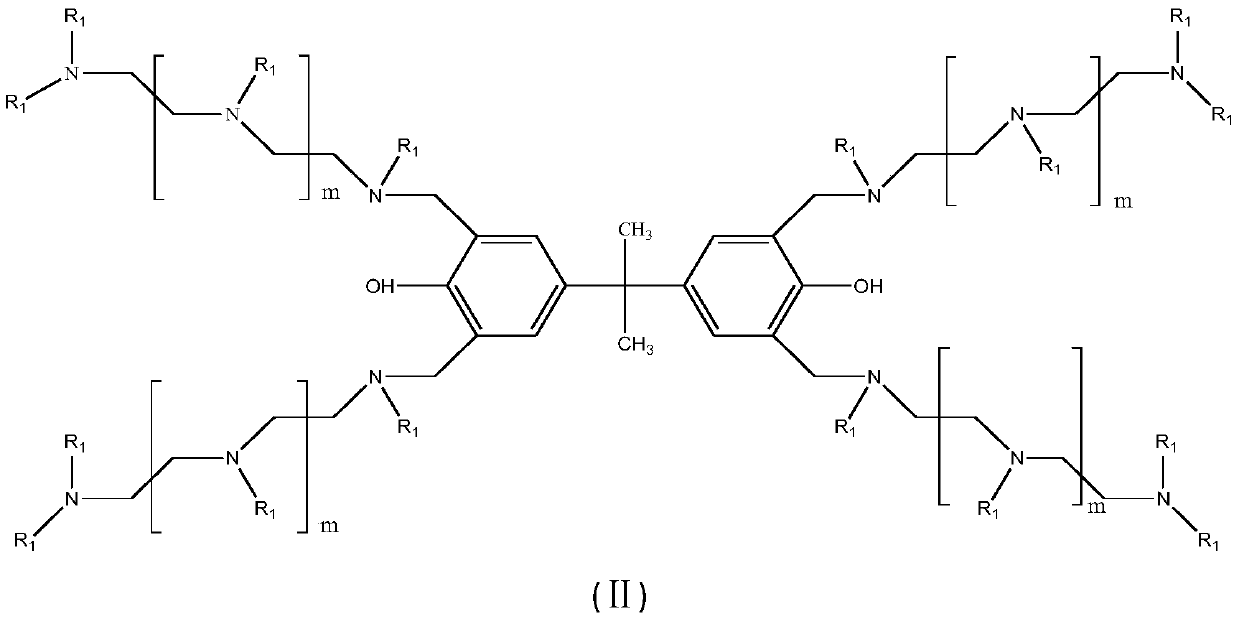Reverse-phase emulsion breaker with polymer produced liquid and method for preparing reverse-phase emulsion breaker
A reverse-phase demulsifier and reaction technology, which is applied in the direction of dehydration/demulsification by chemical methods, can solve the problems of inapplicable reverse-phase demulsifier and achieve good demulsification effect
- Summary
- Abstract
- Description
- Claims
- Application Information
AI Technical Summary
Problems solved by technology
Method used
Image
Examples
Embodiment 1
[0023] Embodiment 1: the synthesis of inverse demulsifier a
[0024] (1) Synthesis of multi-branched phenolamine resin
[0025] Stir and mix bisphenol A and diethylenetriamine evenly. After the two are dissolved at 60°C, slowly add formaldehyde dropwise. After the dropwise addition, continue to keep warm. The whole reaction time is 8h. The added amounts of bisphenol A, diethylenetriamine and formaldehyde were 22.8g, 36.1g and 26.3g respectively (the molar ratio of bisphenol A, diethylenetriamine and formaldehyde was 1:3.5:3.5).
[0026] (2) Polymerization reaction of phenolamine resin and epichlorohydrin
[0027] Add the phenolic amine resin and NaOH prepared in step (1) into the high-temperature and high-pressure reactor in sequence, heat up after sealing, and when the temperature is close to 120°C, slowly, continuously, and a small amount of epichlorohydrin are introduced to carry out the polymerization reaction, and the pressure of the reactor is It should be lower than 0...
Embodiment 2
[0030] Embodiment 2: the synthesis of inverse demulsifier b
[0031] (1) Synthesis of multi-branched phenolamine resin
[0032] Stir and mix bisphenol A and triethylenetetramine evenly. After the two are dissolved at 70°C, slowly add formaldehyde dropwise. After the dropwise addition, continue to keep warm. The whole reaction time is 6h. The addition amounts of bisphenol A, triethylenetetramine and formaldehyde were 22.8g, 58.5g and 30.0g respectively (the molar ratio of bisphenol A, triethylenetetramine and formaldehyde was 1:4.0:4.0).
[0033] (2) Polymerization reaction of phenolamine resin and epichlorohydrin
[0034] Add the phenolic amine resin and KOH prepared in step (1) into the high-temperature and high-pressure reactor in sequence, and heat up after sealing. When the temperature is close to 110°C, slowly, continuously, and a small amount of epichlorohydrin are introduced to carry out the polymerization reaction. The pressure of the reactor is It should be lower th...
Embodiment 3
[0037] Embodiment 3: the synthesis of inverse demulsifier c
[0038] (1) Synthesis of multi-branched phenolamine resin
[0039] Stir and mix bisphenol A and tetraethylenepentamine evenly. After the two are dissolved at 80°C, slowly add formaldehyde dropwise. After the dropwise addition, continue to keep warm. The whole reaction time is 4h. The added amounts of bisphenol A, tetraethylenepentamine and formaldehyde were 22.8g, 85.2g and 33.8g respectively (the molar ratio of bisphenol A, tetraethylenepentamine and formaldehyde was 1:4.5:4.5).
[0040] (2) Polymerization reaction of phenolamine resin and epichlorohydrin
[0041] The phenolamine resin prepared by step (1) and Na 2 CO 3 Sequentially add to the high-temperature and high-pressure reactor, and heat up after sealing. When the temperature is close to 100°C, slowly, continuously, and a small amount of epichlorohydrin is introduced to carry out the polymerization reaction. The pressure of the reactor should be lower tha...
PUM
 Login to View More
Login to View More Abstract
Description
Claims
Application Information
 Login to View More
Login to View More - R&D Engineer
- R&D Manager
- IP Professional
- Industry Leading Data Capabilities
- Powerful AI technology
- Patent DNA Extraction
Browse by: Latest US Patents, China's latest patents, Technical Efficacy Thesaurus, Application Domain, Technology Topic, Popular Technical Reports.
© 2024 PatSnap. All rights reserved.Legal|Privacy policy|Modern Slavery Act Transparency Statement|Sitemap|About US| Contact US: help@patsnap.com










